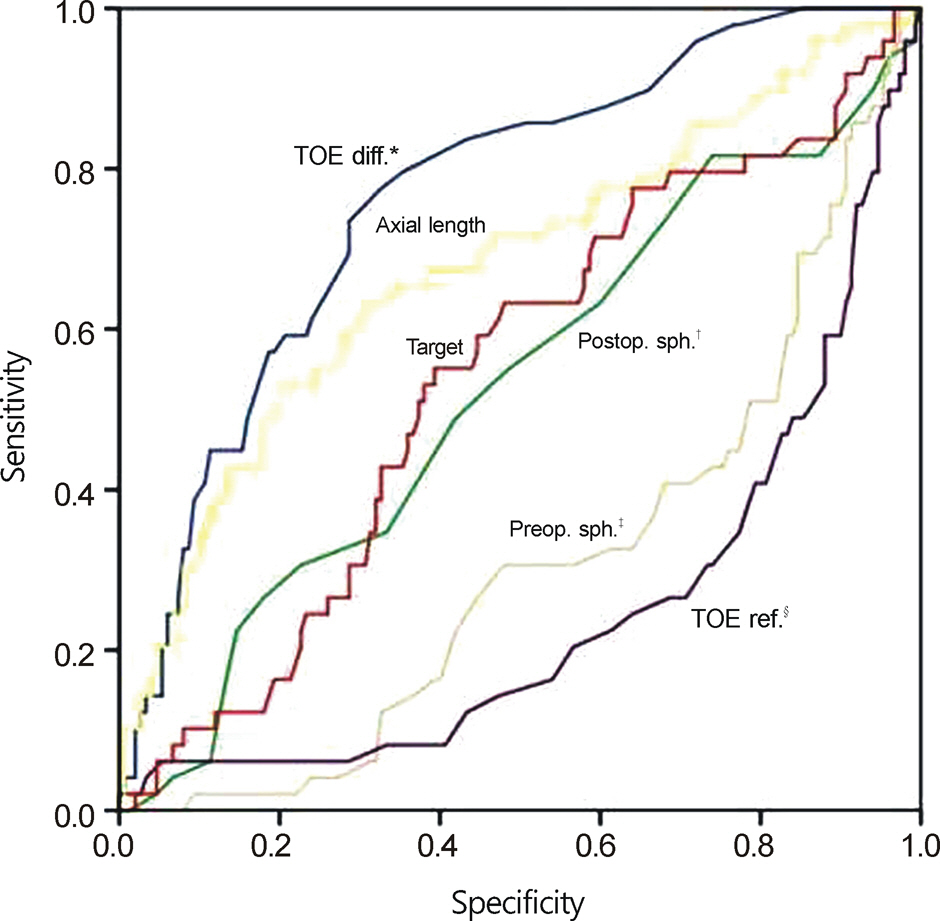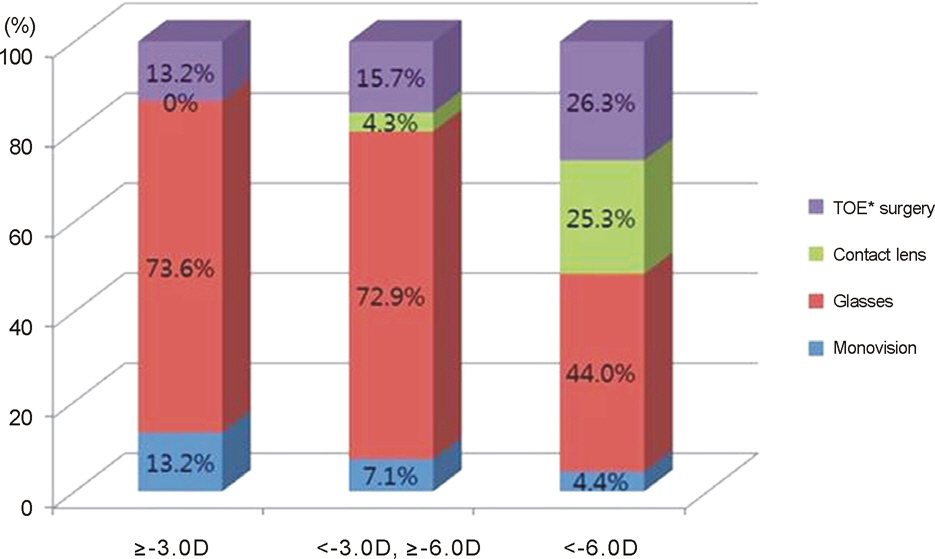J Korean Ophthalmol Soc.
2014 Jun;55(6):817-825.
Target Refraction and Satisfaction of Patients with Binocular Myopia and Monocular Cataract
- Affiliations
-
- 1Department of Ophthalmology and Visual Science, The Catholic University of Korea College of Medicine, Seoul, Korea. mskim@catholic.ac.kr
Abstract
- PURPOSE
To evaluate the target refraction of patients with binocular myopia and monocular cataract after intraocular lens (IOL) implantation.
METHODS
This study comprised 199 patients with binocular myopia (axial length >25 mm) and monocular cataract after IOL implantation for the removal of the monocular cataract. The research was conducted using a questionnaire method and by performing statistical analysis of the refractive outcomes.
RESULTS
The patients are grouped into 3 domains (< or =-3 D group, -3~-6 D group, >-6 D group). There were no statistically significant differences among the 3 groups; whereas the satisfaction of the present corrected state was statistically low in the >-6 D group (p < 0.05). The satisfaction of the corrected state was statistically high in the group of postoperative anisometropia under 3 D (p < 0.05). There was no statistical difference between the groups on the satisfaction of target diopter (-2~-3 D or emmetropia). In terms of correction method, glasses were worn in 119 patients (60%), contact lenses were worn in 26 patients (13%), and monovision was used in 14 patients (7%) were used respectively. Forty patients (20%) with implanted IOL in both eyes did not use any of the correction methods above. Except for the contact lens group, the general satisfaction and the satisfaction of the present corrected state were statistically lower than the other group (p < 0.05). There was no statistically significant difference among the 3 groups in the percentage of cataract surgery in the fellow eye.
CONCLUSIONS
There was no statistical difference between the groups in satisfaction of target diopter (-2~-3 D or emmetropia). Setting the target refraction difference between both eyes less than 3 D leads to more satisfactory outcomes.
Keyword
MeSH Terms
Figure
Reference
-
References
1. Jung SK, Lee JH, Kakizaki H, Jee D. Prevalence of myopia and its association with body stature and educational level in 19-year-old male conscripts in seoul, South Korea. Invest Ophthalmol Vis Sci. 2012; 53:5579–83.
Article2. Mangione CM, Lee PP, Pitts J, et al. Psychometric properties of the National Eye Institute Visual Function Questionnaire (NEI-VFQ). NEI-VFQ Field Test Investigators. Arch Ophthalmol. 1998; 116:1496–504.3. Mangione CM, Lee PP, Gutierrez PR, et al. Development of the 25-item National Eye Institute Visual Function Questionnaire. Arch Ophthalmol. 2001; 119:1050–8.4. Heo JW, Yoon HS, Shin JP, et al. A validation and reliability study of the Korean Version of National Eye Institute Visual Function Questionnaire 25. J Korean Ophthalmol Soc. 2010; 51:1354–67.
Article5. Stenström S. Untersuchungen über die variation und kovariation der optischen elemente des menschlichen Auges. Acta Ophthalmol. 1946; 26:101–3.6. Johannsdottir KR, Stelmach LB. Monovision: a review of the sci-entific literature. Optom Vis Sci. 2001; 78:646–51.7. Evans BJ. Monovision: a review. Ophthalmic Physiol Opt. 2007; 27:417–39.
Article8. Ito M, Shimizu K, Amano R, Handa T. Assessment of visual per-formance in pseudophakic monovision. J Cataract Refract Surg. 2009; 35:710–4.
Article9. Ito M, Shimizu K, Iida Y, Amano R. Five-year clinical study of patients with pseudophakic monovision. J Cataract Refract Surg. 2012; 38:1440–5.
Article10. Greenbaum S. Monovision pseudophakia. J Cataract Refract Surg. 2002; 28:1439–43.
Article11. Finkelman YM, Nq JQ, Barrett GD. Patient satisfaction and visual function after pseudophakic monovision. J Cataract Refract Surg. 2009; 35:998–1002.
Article12. Xiao J, Jiang C, Zhang M. Pseudophakic monovision is an important surgical approach to being spectacle-free. Indian J Ophthalmol. 2011; 59:481–5.
Article13. Marques FF, Sato RM, Chiacchio BB, et al. Evaluation of visual performance and patient satisfaction with pseudophakic mono-vision technique. Arq Bras Oftalmol. 2009; 72:164–8.
Article14. Hayashi K, Yoshida M, Manabe S, Hayashi H. Optimal amount of anisometropia for pseudophakic monovision. J Refract Surg. 2011; 27:332–8.
Article15. Kim YJ, Cheon MH, Ko DA, et al. Visual function and patient sat-isfaction in pseudophakic monovision. J Korean Ophthalmol Soc. 2012; 53:1621–9.
Article
- Full Text Links
- Actions
-
Cited
- CITED
-
- Close
- Share
- Similar articles
-
- The Long-Term Refractive Change after Cataract Surgery in Myopic Patients with a History of LASIK
- LASIK for Myopia with Presbyopia Using the Aspheric Micro-Monovision Technique
- The Refractive Change After Cataract Surgery in Patients With Acute Primary Angle Closure
- Clinical Usefulness of Binocular Multifocal Electroretinography in Patients with Monocular Macular Disease
- The Study on The Near Point in Koreans



